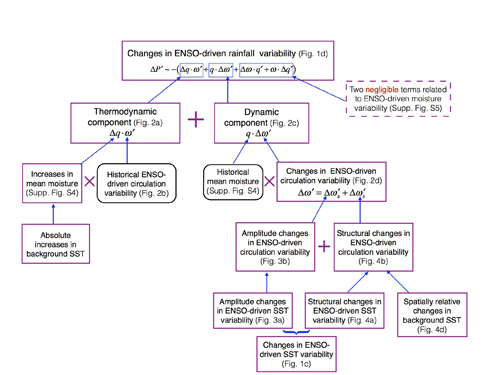
In addition to the global-mean temperature increases due to greenhouse gases, the changes in extreme climate events, such as droughts, floods and hot waves, are of great concerns of scientists working on climate change research. As a key driver of global extreme climate events, the anomalous events of sea surface temperature (SST) occurring in the equatorial East Pacific, known as ENSO events, have attracted big attention. How will ENSO and its impacts change under global warming?

Convective rainfall over tropical ocean (Photo Courtesy of HUANG Ping)
In early studies, a large portion of studies focused on the characteristics and mechanisms of changes in ENSO-related SST anomalies. However, there was no robust projection obtained because of its complexity and the faultiness of climate models. Recently, scientists have paid increasing attention to the crucial bridge, the tropical Pacific rainfall, through which ENSO impacts global climate. During an ENSO event, the equatorial SST anomalies first induce anomalies of convective rainfall over the tropical Pacific, which then heat the upper troposphere and finally affect global climate under the transportation of atmospheric waves. Some studies argued that the tropical Pacific rainfall anomalies induced by ENSO very likely enhance and move east, implying large changes in ENSO's global impacts, whereas the ENSO-related SST variabilities are projected to possibly decrease.

Diagram illustrating the formation mechanisms of the changes in ENSO-driven rainfall variability. (Image by HUANG and XIE, 2015)
In a new paper published online this week in Nature Geoscience, Dr. HUANG Ping from Institute of Atmospheric Physics, Chinese Academy of Sciences, and Prof. Shang-Ping XIE from Scripps Institution of Oceanography, revealed the mechanisms of change in ENSO-induced tropical Pacific rainfall variability under global warming. This research builds a general framework to explain the change in rainfall variability due to nonlinear interactions of changes in the mean state and internal variability of SST, moisture and vertical motion, with the help of a moisture budget decomposition for simulations from eighteen state-of-the-art climate models.
The research identifies that the increase in mean-state moisture content associated with surface warming enhances ENSO-related rainfall anomalies, whereas the projected reduction in ENSO-related SST variability decreases rainfall. These two opposing mechanisms approximately offset each other. Two additional effects—greater warming in background SST over the central-eastern Pacific and more frequent central Pacific-ENSO events—both enhance central-eastern Pacific rainfall variability and dampen it over the western Pacific. This result supports that the ENSO-induced tropical Pacific rainfall anomalies, together with the patterns of ENSO's global impacts, very likely move east.
This study clarifies the mechanisms connecting ENSO-related SST variability and tropical Pacific rainfall variability, the key process of ENSO influencing global climate. It provides a solid contribution to more reliable projections on change in ENSO's global impacts in future.
The general framework of change in tropical Pacific rainfall variability is not limited to ENSO. It can also be applied to explain change in internal variability of tropical rainfall due to nonlinear interactions of changes in the mean state and internal variability of SST, moisture and vertical motion.

86-10-68597521 (day)
86-10-68597289 (night)

86-10-68511095 (day)
86-10-68512458 (night)

cas_en@cas.cn

52 Sanlihe Rd., Xicheng District,
Beijing, China (100864)

